When you're gearing up for a ride on your Kawasaki Z1000, the battery you choose can make all the difference in performance and reliability. You need a battery that not only fits your bike's specifications but also meets your riding demands. From Weize to Yuasa, each option offers unique advantages that could enhance your experience. Before you rush into a decision, it's crucial to take into account factors like cold cranking amps and maintenance requirements. So, which batteries rise to the top, and what should you know to power up your ride confidently?
Key Takeaways
- Choose a battery with at least 10 AH capacity for reliable performance in your Kawasaki Z1000.
- Opt for AGM batteries like Weize or Yuasa for durability and minimal maintenance.
- Ensure the battery's dimensions match the Z1000's compartment for a proper fit.
- Consider cold cranking amps (CCA); higher ratings guarantee better starting in colder conditions.
Weize YTX7L BS Maintenance Free ATV Battery
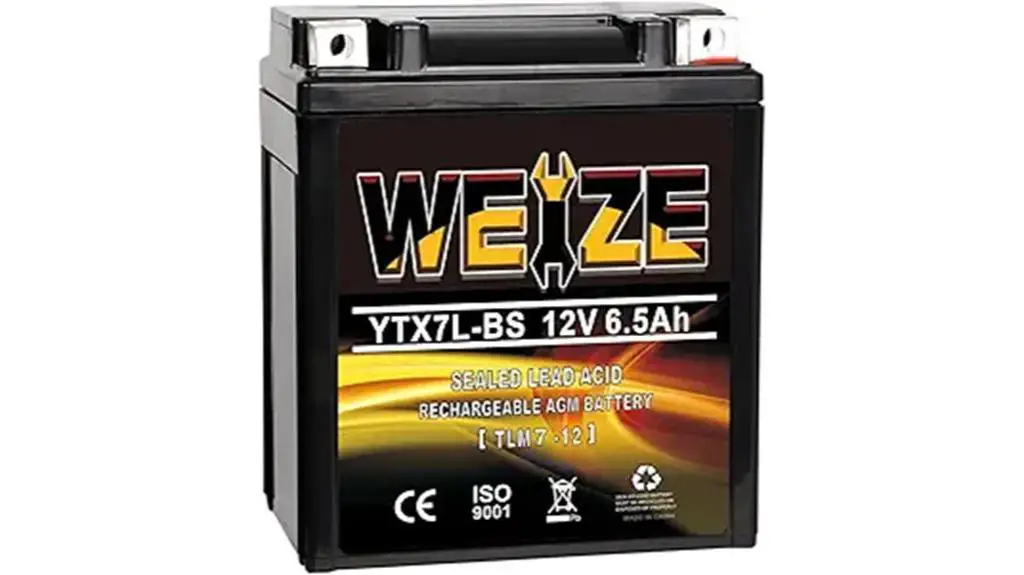
The Weize YTX7L-BS Maintenance Free ATV Battery is an ideal choice for Kawasaki Z1000 owners seeking a reliable power source that combines performance with hassle-free maintenance.
This battery operates at 12 volts with a 6.5 AH capacity, utilizing SLA and AGM chemistry for enhanced durability.
Weighing just under five pounds, it fits snugly in various models, making it a versatile option.
Customers have rated it 4.3 out of 5 stars, appreciating its dependable performance and value compared to pricier alternatives.
The battery comes with a 30-day return guarantee, ensuring peace of mind.
Regular replacement every two years can help prevent starting issues, making it a smart choice for those who want a long-lasting, maintenance-free battery solution.
Best For: Riders of motorcycles and ATVs, particularly those seeking a dependable and maintenance-free battery solution.
Pros:
- High customer satisfaction with performance and reliability, as indicated by a 4.3 out of 5-star rating.
- Lightweight and compact design makes it easy to install in various compatible models.
Cons:
- Some customers report packaging issues that can lead to minor leaks upon arrival.
- Battery life may vary, with some users experiencing a short lifespan of around two years despite proper maintenance.
Powerextra Replacement Battery for Kawasaki 19.2V
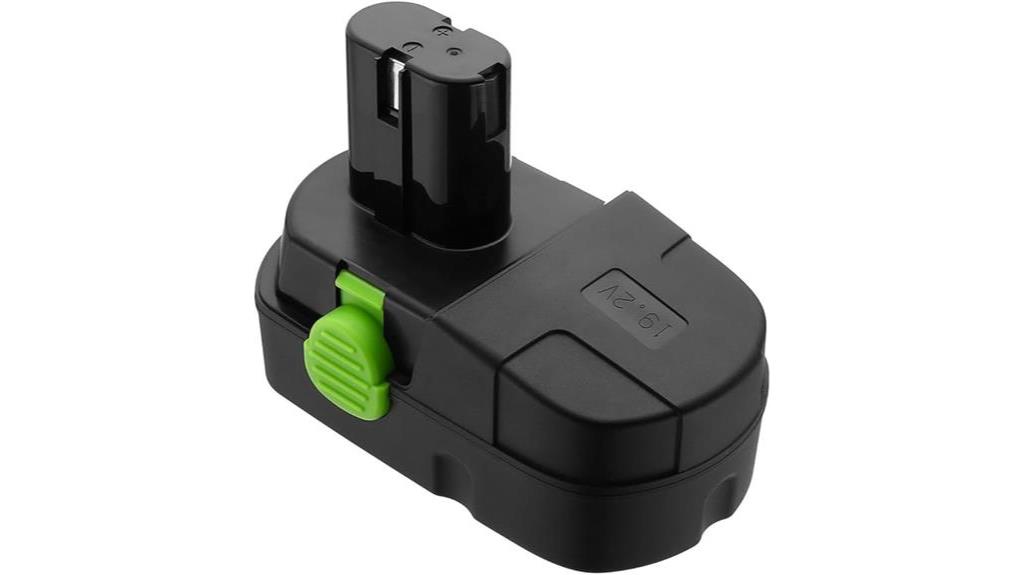
Designed specifically for Kawasaki Unisource tools, the Powerextra 19.2V Replacement Battery boasts a robust capacity of 3000mAh, making it an excellent choice for those seeking reliable power.
This NI-MH battery operates at 19.2 volts and delivers an energy output of 57.6Wh. Compatible with various Kawasaki models, including 69007 and 691240, it requires the Kawasaki charger 690072E for peak performance.
The Powerextra battery features top A-grade cells and a built-in microchip that prevents overcharging, enhancing its lifespan. Customers appreciate the 30-day money-back guarantee and the 12-month limited warranty, reflected in its solid 4.4 out of 5-star rating.
Weighing just 2.2 pounds, it's a practical and dependable option for Kawasaki enthusiasts.
Best For: Users of Kawasaki Unisource tools looking for a reliable and high-capacity replacement battery.
Pros:
- Top A-grade battery cells ensure consistent performance and longevity.
- Built-in microchip prevents overcharging and enhances safety.
Cons:
- Only compatible with specific Kawasaki models and charger, limiting versatility.
- Weight of 2.2 pounds may be considered heavy for some users.
Weize YTX12-BS Motorcycle Battery
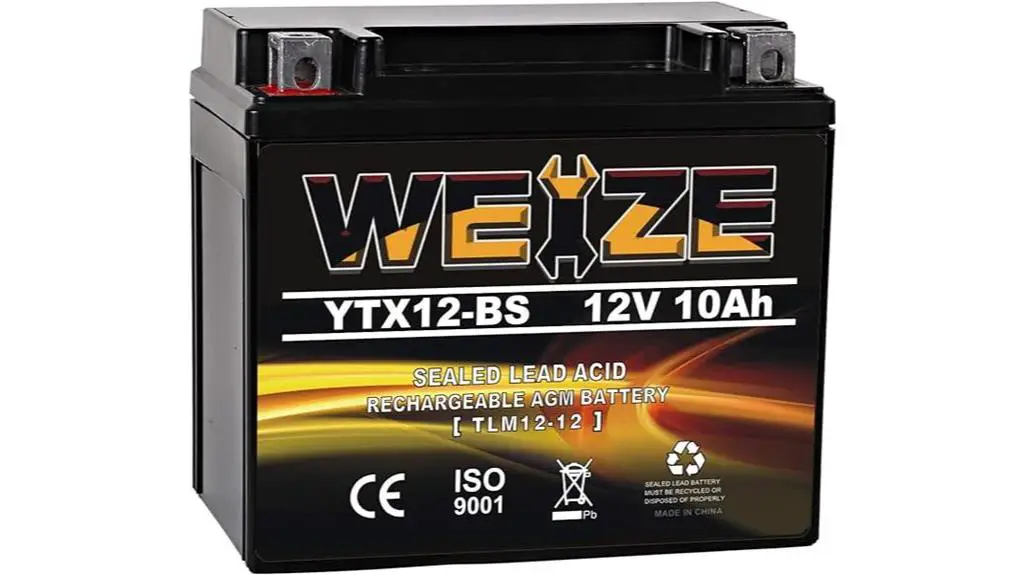
Offering a reliable 12-volt power source, the Weize YTX12-BS Motorcycle Battery is an excellent choice for Kawasaki Z1000 owners seeking performance and longevity in a maintenance-free design.
Weighing just 7.92 lbs and measuring 5.91 in x 3.43 in x 5.12 in, this sealed lead-acid battery boasts a 10 amp-hour capacity for outstanding power delivery.
Its absorbed glass mat (AGM) technology guarantees durability and efficiency, making it suitable for various vehicles, including motorcycles and ATVs.
With a solid average rating of 4.3 stars from nearly 37,000 reviews, customers praise its reliability and responsive customer support.
Weize offers a 12-month warranty, emphasizing their commitment to quality and satisfaction for users looking to power their rides confidently.
Best For: Motorcycle and ATV enthusiasts looking for a reliable, maintenance-free battery with excellent performance.
Pros:
- High capacity: 10 amp-hour rating provides strong power delivery.
- Durable design: Absorbed glass mat (AGM) technology ensures longevity and efficiency.
Cons:
- Initial faults: Some users reported issues with battery faults upon installation.
- Terminal installation concerns: There are complaints about terminal nuts falling out during setup.
Yuasa YUAM329BS YTX9-BS Maintenance Free AGM Battery with Acid pack
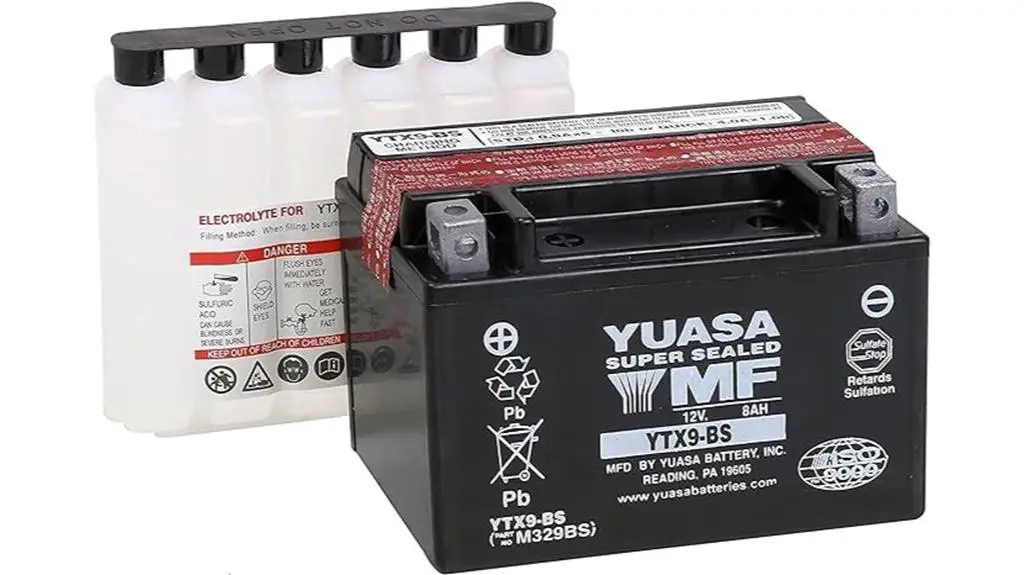
Yuasa's YUAM329BS YTX9-BS battery stands out for Kawasaki Z1000 owners seeking a reliable, maintenance-free option with impressive cold cranking amps for superior starting power in challenging weather conditions.
This AGM battery, weighing 6.6 lbs, features advanced lead-calcium technology, maintaining specific gravity longer than traditional batteries. With a capacity of 8 Ah and 135 C.C.A. at 0°F, it's designed to perform even in the coldest climates.
Installation is straightforward, as users simply add the supplied electrolyte. Its nonspillable design promotes safety, while regular charging keeps it in prime condition.
Many users report a lifespan of 6-10 years, making it a worthy investment for riders who prioritize performance and longevity.
Best For: Riders of Kawasaki Z1000 seeking a reliable, maintenance-free battery with excellent cold-start performance.
Pros:
- Maintenance-free design eliminates the need for water addition.
- High cold cranking amps (135 C.C.A.) ensure reliable starting in cold weather.
Cons:
- Requires initial activation with sulfuric acid, which should be done outdoors.
- Mixed reviews on customer service and support experiences.
Amazon Basics AAA Alkaline Batteries (36 Count)
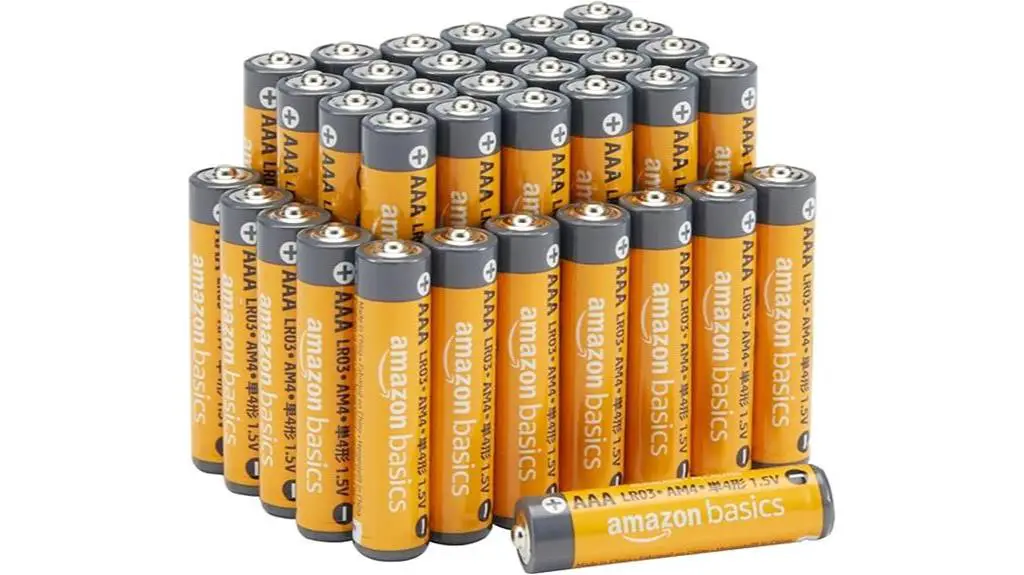
Kawasaki Z1000 owners looking for reliable power solutions will appreciate the long-lasting performance of Amazon Basics AAA Alkaline Batteries, perfect for keeping essential electronic devices operational.
This 36-count pack delivers a 10-year leak-free shelf life, making it ideal for game controllers, toys, flashlights, and digital cameras.
Weighing only 0.393 ounces each and measuring 0.39 x 0.39 x 1.73 inches, these batteries are compact yet powerful.
With a customer rating of 4.7 out of 5 stars from over 733,000 reviews, users praise their reliability and durability.
Priced at approximately $0.31 per battery, they offer excellent value for bulk purchases, ensuring Kawasaki Z1000 owners are well-equipped for any situation requiring dependable battery power.
Best For: Kawasaki Z1000 owners and anyone seeking reliable power solutions for electronic devices.
Pros:
- Long-lasting performance with a 10-year leak-free shelf life.
- High customer rating of 4.7 out of 5 stars from over 733,000 reviews.
Cons:
- Slightly more expensive per mAh compared to some alternatives like ACDelco.
- Not rechargeable; users needing rechargeable options must seek other products.
Amazon Basics 48-Pack AA Alkaline Batteries
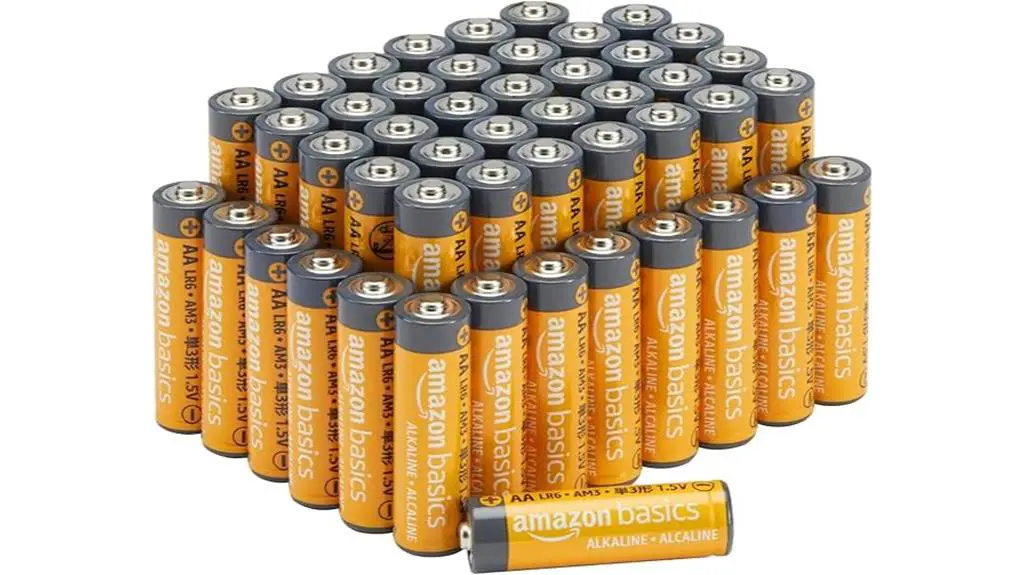
The Amazon Basics 48-Pack AA Alkaline Batteries provides exceptional reliability for motorcycle enthusiasts needing dependable power for their Kawasaki Z1000 accessories and devices.
With a voltage of 1.5 volts and an impressive shelf life of 10 years, these batteries guarantee that users have a long-lasting power source ready for various applications.
Weighing 2.54 pounds and measuring 9.21 x 6.22 x 1.42 inches, the pack is convenient to store, featuring individually wrapped batteries for easy access.
Customers appreciate the exceptional charge retention and leak-free performance, with a stellar rating of 4.7 out of 5 stars from nearly 400,000 reviews.
Ideal for emergencies or everyday use, these batteries offer great value and reliability compared to name-brand options.
Best For: Those seeking a reliable and long-lasting power source for various devices and emergencies, such as motorcycle enthusiasts using Kawasaki Z1000 accessories.
Pros:
- Exceptional shelf life of 10 years, ensuring readiness for use when needed.
- Individually wrapped batteries for easy storage and accessibility.
Cons:
- Not rechargeable, limiting their long-term use compared to rechargeable options.
- May not be suitable for high-drain devices that require more power.
Duracell Optimum AA Batteries, 12 Count Pack
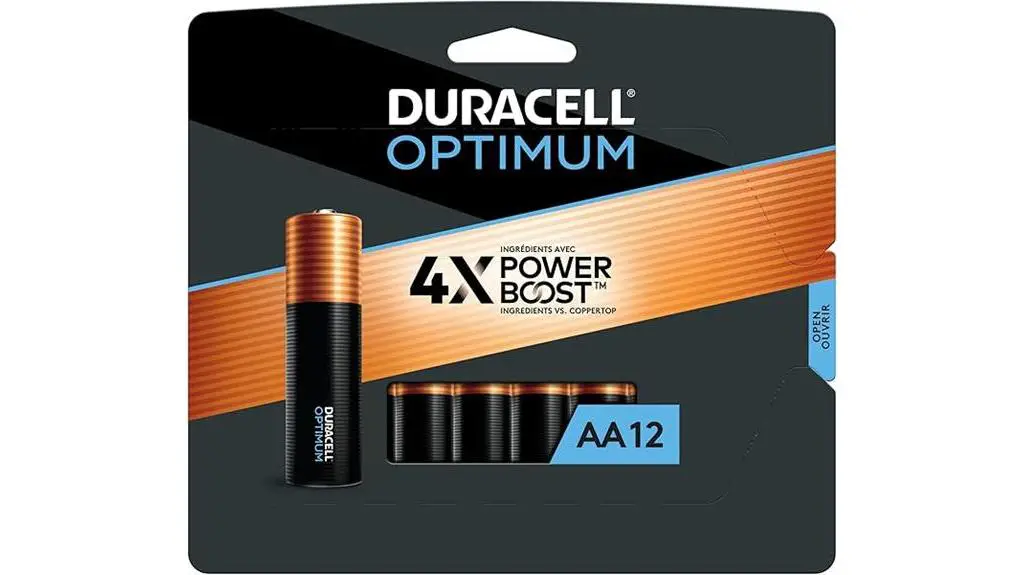
For those seeking dependable power for high-drain devices, the Duracell Optimum AA Batteries in a 12 Count Pack stand out due to their enhanced longevity and performance.
Featuring 4X Duracell's patented POWER BOOST Ingredients, these batteries are recognized as the #1 best-performing AA alkaline batteries.
They come packaged in a resealable slider pack, allowing for organized storage.
While some users reported mixed experiences regarding battery lifespan, many praised their reliability, especially in devices like doorbells.
Although the price point may be higher than other options, many consumers find the performance justifies the investment.
Duracell's strong brand reputation further reinforces these batteries as a preferred choice for anyone needing consistent power in various applications.
Best For: Those needing reliable power for high-drain devices and a trusted battery brand.
Pros:
- Enhanced performance with 4X Duracell's patented POWER BOOST Ingredients.
- Resealable packaging for organized storage and convenience.
Cons:
- Mixed reviews regarding battery longevity, with some users noting shorter life spans.
- Higher price point compared to other battery options may deter budget-conscious consumers.
Factors to Consider When Choosing a Battery for Kawasaki Z1000
When choosing a battery for your Kawasaki Z1000, you need to take into account several critical factors.
You'll want to look at the voltage requirements, amperage capacity, and the battery's dimensions to guarantee a proper fit.
Additionally, compatibility with battery type and cold cranking amps are essential for peak performance.
Voltage Requirements
Choosing the right battery voltage is essential for ensuring your Kawasaki Z1000 runs smoothly and efficiently. The standard voltage requirement for your Z1000 is 12 volts. It's vital to match this voltage with the manufacturer's specifications to prevent any electrical issues or starting failures.
If you opt for a battery with a lower voltage than needed, you might experience insufficient power when starting the engine or operating electrical components. On the flip side, using a battery with a higher voltage can lead to potential damage to your bike's electrical system due to excessive power output.
To avoid these problems, always double-check the voltage requirements in your owner's manual or consult with a professional before making a purchase. This careful consideration won't only enhance the performance of your Z1000 but also prolong the life of your electrical system.
Amperage Capacity
Understanding the amperage capacity of a battery is crucial for guaranteeing your Kawasaki Z1000 starts reliably and powers its electrical components effectively. The capacity, measured in amp-hours (AH), indicates how much current your battery can supply over a specific period.
For ideal performance, select a battery with an amperage capacity that meets or exceeds the manufacturer's specifications, typically around 10 AH or higher.
Choosing a battery with a higher amperage capacity can greatly improve cold cranking amps (CCA), which is essential for starting your motorcycle in chilly conditions. This added strength helps assure that your bike fires up without issue, even when the temperature drops.
In addition, a battery with sufficient capacity guarantees reliable power delivery for your accessories and electronics, preventing any drain during extended rides.
To maintain consistent starting performance, consider replacing your battery every two years. Regular replacement keeps your amperage capacity at the necessary level, guaranteeing your Kawasaki Z1000 remains ready to ride at a moment's notice.
Dimensions and Fitment
Making certain your new battery fits snugly in the Kawasaki Z1000's compartment is essential for ideal performance and safety. Start by checking the battery's dimensions carefully. If the size is off, you might face installation issues that can affect your bike's functionality. Additionally, pay attention to the terminal locations. Misaligned terminals can prevent proper connections, leading to starting problems.
Cold cranking amps (CCA) are another critical factor to take into account. A battery with sufficient CCA guarantees reliable starting, especially in colder weather conditions, so don't overlook this aspect. It's also wise to compare the specifications of your old battery, including amperage and chemistry type, with the new one. This guarantees compatibility with your Z1000's electrical system.
Lastly, measure the available space in the battery housing before making a purchase. Proper fitment not only allows for easy installation but also prevents potential damage to your bike's battery housing and electrical components.
Battery Type Compatibility
When selecting a battery for your Kawasaki Z1000, you'll want to confirm it's compatible with the bike's specific power requirements and electrical system. Most models require a 12V battery, typically found in sealed lead acid (SLA) or absorbed glass mat (AGM) types. Both options offer maintenance-free convenience, making them popular choices.
It's vital to verify the dimensions and terminal configurations of your new battery match the original to avoid fitment issues. A proper connection is essential for reliable performance.
Additionally, while you should check the cold cranking amps (CCA) for ideal starting power, it's advisable to focus on the overall compatibility with your specific model year. Battery requirements can vary across different production years, so double-check to avoid any mismatches.
Replacing your battery every two years is also recommended to prevent starting issues and maintain your motorcycle's performance.
Cold Cranking Amps
Cold Cranking Amps (CCA) play a crucial role in guaranteeing your Kawasaki Z1000 starts reliably, especially in chilly conditions.
CCA measures the battery's ability to start the engine when temperatures drop, indicating how much current the battery can provide for 30 seconds at 0°F (-18°C) without falling below a specified voltage.
When choosing a battery, aim for a higher CCA rating, particularly if you ride in colder climates. A battery with a CCA rating between 100 to 200 amps is typical for motorcycles, but performance can vary based on battery chemistry and construction.
Always match or exceed the original equipment manufacturer's (OEM) CCA specifications to maintain maximum starting power and prevent any starting issues.
It's also wise to regularly check your battery's CCA. A decrease in CCA performance can signal that your battery is losing its ability to start your bike, leading to potential difficulties.
Maintenance Considerations
Regularly maintaining your Kawasaki Z1000's battery is vital for guaranteeing it operates at peak performance and avoids unexpected starting issues. Begin by checking the charge level frequently; a well-charged battery is essential for reliable starts. Clean the terminals regularly to prevent corrosion, which can hinder performance.
It's a good idea to replace your battery every two years. This proactive approach helps maintain consistent starting power and sidesteps any unexpected failures. When choosing a new battery, pay attention to the cold cranking amps (CCA); higher CCA ratings secure better performance in colder weather conditions, making your rides smoother.
Compatibility is another important factor. Verify the terminal locations and specifications for your Kawasaki Z1000 to confirm a secure fit and reliable operation.
If you plan on leaving your bike unused for a while, consider using a battery tender or trickle charger. This will help maintain the charge and extend the battery's lifespan, making sure you're ready to hit the road when the time comes.
Frequently Asked Questions
How Long Do Motorcycle Batteries Typically Last?
Motorcycle batteries typically last between three to five years, depending on usage and maintenance. If you ride frequently and keep your battery charged, it might last longer.
However, extreme temperatures and lack of care can shorten its lifespan. To maximize battery life, regularly check the terminals, keep it clean, and guarantee it's properly charged.
If you notice issues, it's best to replace it before your next ride to avoid being stranded.
Can I Use a Car Battery for My Kawasaki Z1000?
Using a car battery in your Kawasaki Z1000 isn't advisable.
Motorcycle batteries are designed to deliver high bursts of power for starting, while car batteries provide steady power over longer periods.
Did you know that motorcycle batteries typically have a lifespan of 2-5 years?
If you use a car battery, you risk damaging your bike's electrical system.
Stick with a battery designed for motorcycles to guarantee peak performance and longevity.
What Is the Average Cost of a Replacement Battery?
When you're looking to replace your motorcycle battery, the average cost typically ranges from $50 to $150, depending on the type and brand you choose.
You'll find that maintenance-free batteries often fall on the higher end of that spectrum.
It's smart to shop around and compare prices, as some retailers might offer promotions or discounts.
Investing in a reliable battery guarantees your bike runs smoothly and starts without a hitch.
How Do I Properly Dispose of an Old Motorcycle Battery?
Did you know that about 12 million tons of batteries are improperly disposed of each year?
To properly dispose of your old motorcycle battery, take it to a recycling facility or a local automotive shop that accepts used batteries. Many retailers even offer recycling programs.
Never throw it in the trash, as it can leak harmful chemicals.
Do I Need a Special Charger for My Kawasaki Z1000 Battery?
You don't necessarily need a special charger for your Kawasaki Z1000 battery, but it's essential to use a charger compatible with your battery type.
If your bike has a lithium battery, opt for a lithium-specific charger to avoid damage.
Always check the specifications and verify the charger provides the correct voltage and amperage.
Using the right equipment will help maintain your battery's lifespan and performance, so it's worth investing in a quality charger.
Conclusion
Now that you know the best battery options for your Kawasaki Z1000, imagine the thrill of a smooth, powerful ride every time you hit the road.
Picture yourself cruising through winding paths, confident that your bike will start without a hitch, no matter the weather.
Don't let a weak battery spoil your adventures—choose wisely and power up your ride.
The open road awaits; are you ready to release the full potential of your Z1000?